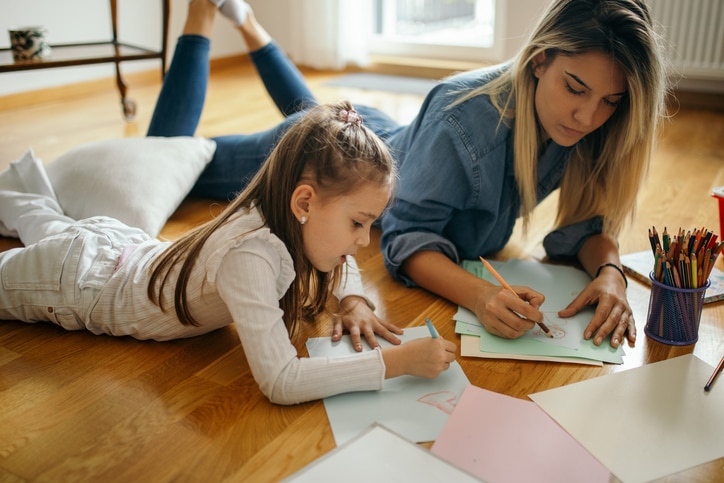In this article
Not every job can be done at home, but many — including babysitting — can. While traditionally, babysitting involves caring for children in the family’s home, babysitting at home (your own home) is an option, too. But before you embark on this work set-up, there are a number of things of which to be aware.
“Babysitting at home is completely different from running an at-home daycare,” explains Stephanie Fornaro, the founder and CEO of Hello, Nanny, a nationwide placement agency, noting that the former has a much less formal schedule than the latter.
Interested in babysitting at home? Experts share what to know — and what to expect — when caring for kids under your own roof.
“…babysitting at home is more casual and usually short-term, with just one or two kids.”
— Stephanie Fornaro, founder and CEO, Hello, Nanny
Babysitting at home vs. at-home daycare
Put simply, at-home daycare, sometimes referred to as family daycare or group daycare, is a business. “With this set-up, you’re likely caring for several kids regularly, following state regulations and need a license,” Fornaro notes.
“On the other hand,” she continues, “babysitting at home is more casual and usually short-term, with just one or two kids.”
Pros of babysitting at home
When it comes to at-home babysitting jobs, the perks are similar to other work-from-home gigs. Here are a few advantages, per Fornaro:
- Convenience (no commute).
- You can set your own hours.
- You can decide the number of kids.
- If you have kids of your own, they get built-in playmates.
Cons of babysitting at home
With every set of pros, there are cons to match. When it comes to at-home sitting, the biggest factor to consider is liability, says Michelle LaRowe Conover, lead educator at Global Nanny Training.
“If you’re considering sitting at home, you may wish to consult with your insurance carrier to determine if you have coverage for offering such services,” Conover says. “You should also consider what safeguards are in place to ensure child safety.”
Also, we’d be remiss if we didn’t say it: The mess.
What trainings and certifications are required?
For casual babysitting, not much is required, Fornaro points out, but having CPR and First Aid certifications is highly (highly!) recommended.
Also consider completing a basic babysitter training course, as well as a background check. There are many background screening services you can opt to use, and Care.com uses third-party vendors to offer background check services that range in comprehensiveness.
Note: For folks considering more of an at-home daycare setup, some states require a “child care license and house inspection, in addition to a background check and possibly training in child development,” adds Fornaro. (More on this shortly.)
At-home babysitting rates
Generally, the rate for babysitting at home is a bit lower than if you’re sitting at the family’s house. This is because “parents are handling drop-offs, meals and other logistics,” according to Fornaro.
“Babysitting at home might be around $10-$20 per hour, but this depends on your area,” she continues. “Nannies or on-site sitters can charge $25 per hour or more.”
Other factors, like location, experience and the number of kids, come into play, too. To get an idea of what babysitters in your area are asking for, check out our Cost of Care Calculator.
Keep in mind, if you earn more than $2,800 from a single family in one year, you need to report your earnings to the IRS. So it’s a good idea to keep track of what you earn from each family per year.
“When caring for children in your home, you should check with your state and local licensing boards to determine what regulations may apply.”
— Michelle LaRowe Conover, lead educator, Global Nanny Training
Are there laws for home babysitters?
Depending on the situation, yes — particularly if you’re watching multiple, unrelated kids regularly. “Many states require a license once you go over a certain number [of kids],” says Fornaro. “You might also need to meet safety requirements, pass a home inspection or follow zoning rules.”
“When caring for children in your home, you should check with your state and local licensing boards to determine what regulations may apply,” Conover says.
You can review the daycare licensing requirements for your state on your local state government website.
That being said, for occasional, casual at-home babysitting, licensing generally is not required.
What to know before babysitting at home
Just because you’re fit to babysit, doesn’t mean your space is. Before caring for kids under your roof, do a little recon to ensure the place is safe and kid-friendly, notes Fornaro. “Think: toys, baby gates and no sharp edges.”
It’s also a good idea to decide on some policies, such as hours, what to do about sick kids and how to handle late pickups — and stick to them. Before having a group of kids over to her house for a “parents night out,” veteran babysitter Emily Marinucci of Cranford, New Jersey, told families both the start and finish time, so no one was at her place too late and the kids knew when things would start to wrap up.
“Also, know your limits!” Fornarno says. “Don’t overcommit to too many kids at once, and be transparent if you have any animals or other adults in the home.”
Should you have families sign a contract?
Fornaro, Conover and Marinucci all agree that a contract is “100%” necessary.
Before hosting a parents night out — something she did a few times a year — Marinucci had everyone sign a contract that “clearly laid expectations out upfront.” The contract also served as a waiver, with parents giving permission for their kids to take part in physical activities, like scavenger hunts, with the knowledge that there was potential for injury.
“It’s not just for you but for the families, too,” Fornaro says. “A contract lays out your hours, pay, rules and expectations so there’s no confusion later. It’s a lifesaver if issues come up.”
The bottom line
Babysitting at home can be a great, flexible gig, but it’s important to weigh the drawbacks, as well as research and prepare on the front end.
“Babysitting at home is super convenient — you’re already home!” Fornaro notes. That being said, making sure your place is kid-friendly (and that you’re prepared to clean up afterwards) are things to consider as well.



